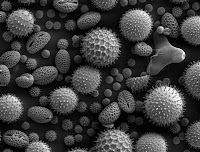Dog Allergy
 |
| Dog Allergy |
Dog Allergy - About 43% of households in the United States is home to a large percentage of Americans test positive for allergies dog "Fido". Up to 30%. Even if some owners of dogs tested positive, but they may not be willing to recognize a connection between their pet and their allergic reactions. For them, the emotional connection they pet their priority.
Pet allergies can strike anyone at any age. As a cat allergens, dog allergens are very small, sticky, and easy. Originally contaminate a dog's skin, saliva and urine, saliva and dander allergens are able to drive you home, everything.
Apart from swimming, dog allergens on the skin of a dog to mount, bringing about allergens. The allergen binds to carpeting, upholstered furniture, mattresses and clothing. As you can imagine, the animals that much drool very unpleasant consequences for those with allergies.
Some pet allergens are breed-specific, so some breeds produce less. Can produce examples of breeds that allergy symptoms for fewer animals are poodles, Airedales, and Schnauzers. They shed their skin about every 21 days. Compare this with Cocker Spaniel, German Shepherd, Irish Setter, dropped their skin every three to four days. If you have a skin allergy dog who would decide what race you are? Click here for detailed information about hypoallergenic breeds of dogs over
Dog allergies can occur, such as human in their companions. These allergies are usually manifested as skin diseases. What this will do is cause the dog's immune system to form a number of different symptoms, including irritation of the skin over-reacting. Unfortunately, allergies are becoming more common every day, as they are with the people.
Irritation of the skin allergies is to identify quite easily. Some symptoms include redness, itching, hair loss and cause recurrent infections of the skin. The dog may start scratching brings more skin problems.
To find symptoms, there are several things that will help determine whether the dog has an allergy to. Sometimes the cigar-shaped mites appear on the skin of the dog. These mites are removed in the hair follicles and sebaceous glands of the skin. Although it is possible to identify what kind of allergy, the dog suffers, it is best to seek the attention of a veterinarian to identify the best possible treatment.
There are a number of different types of dog allergies dogs can be achieved. The top five include allergies, food allergies, flea allergies, contact allergies, bacterial, and atopy.
Allergies
Dog Allergy - Food
The most common symptoms of food allergies consists of skin irritation, excessive itching, hair loss, and hot spots. They can also cause the dog to have loose stools and they even throw occasionally.There are a number of causes of food allergies, including a built-in intolerance to beef, dairy products, chicken, corn and soybeans. Dog food allergies can, over time, they know it still important to make these symptoms develop. The simplest solution is to move to a different dry dog food and see if the problem clears up skin. If this is not the answer, a visit to the vet is necessary for further assistance.
Dog Allergy - Flea
Such as food allergies, the dog will develop redness on the skin, itching, and can start chewing in places. The main cause of dog fleas is flea saliva that irritates the skin of the dog. As for mosquitoes, fleas suck the blood of the animal. Possible treatment is to develop the dog a bath in cool water with a shampoo for chips. If the dog has chewed his own skin, antibiotics are sometimes necessary, depending on the severity of the problem.Dog Allergy - Bacteria
Bacterial allergy can be identified by red marks, pockets of pus, hair loss and skin formation that looks like ringworm. In general, bacteria allergies are secondary to other problems that can have the dog as parasitism or hormonal disorders. It is important to have a blood test to see what the problem is to get real.Dog Allergy - Contact
The symptoms of contact allergy are very similar to flea allergies and bacterial symptoms. The cause of contact allergy to the dog came in contact with all kinds of allergens. All the beds, chemicals, plants or household cleaners can bring contact allergies. There are several treatment methods, including using any kind of shampoo, a form prescribed oral steroids or other natural treatments such as omega-3.Dog Allergy - Atopy
Atopy allergies start with itching, biting, hair loss and facial rub. Other symptoms may be papules, the small red bumps or pustules, small pimple-like lesions. Atopic allergies are usually caused by fleas, but can also be found in your home caused by air, chemicals and most popular products.Related Post : tips to cope with allergies in dogs
